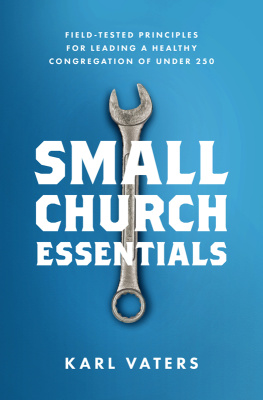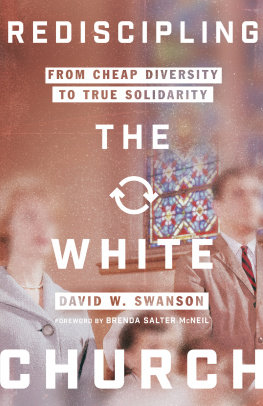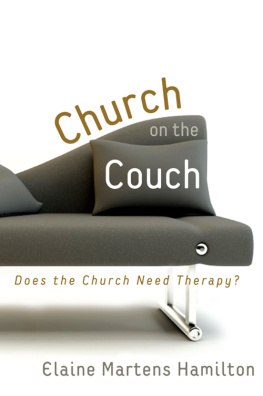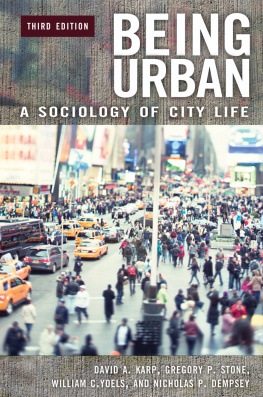The Urban Church Imagined
The Urban Church Imagined
Religion, Race, and Authenticity in the City
Jessica M. Barron and Rhys H. Williams
NEW YORK UNIVERSITY PRESS
New York
NEW YORK UNIVERSITY PRESS
New York
www.nyupress.org
2017 by New York University
All rights reserved
References to Internet websites (URLs) were accurate at the time of writing. Neither the author nor New York University Press is responsible for URLs that may have expired or changed since the manuscript was prepared.
Library of Congress Cataloging-in-Publication Data
Names: Barron, Jessica M., author.
Title: The urban church imagined : religion, race, and authenticity in the city / Jessica M. Barron and Rhys H. Williams.
Description: New York : NYU Press, 2017. | Includes bibliographical references and index.
Identifiers: LCCN 2017008080| ISBN 9781479877669 (cl : alk. paper) | ISBN 9781479887101 (pb : alk. paper)
Subjects: LCSH: City churches.
Classification: LCC BV637 .B28 2017 | DDC 253.09173/2dc23
LC record available at https://lccn.loc.gov/2017008080
New York University Press books are printed on acid-free paper, and their binding materials are chosen for strength and durability. We strive to use environmentally responsible suppliers and materials to the greatest extent possible in publishing our books.
Manufactured in the United States of America
10 9 8 7 6 5 4 3 2 1
Also available as an ebook
Contents
Scholarship is never developed alone. We would like to take this opportunity to thank those who so generously gave of their time and assistance in seeing this project through from initial idea to finished book. That starts with Japonica Brown-Saracino, who provided a tremendous amount of support, feedback, direction, advice, and encouragement throughout the data collection and first drafts of this project. Thank you to Jane Sell and Rogelio Saenz for acting as excellent sounding boards throughout the process. Your mentorship and guidance were invaluable. A special thanks to our colleagues Gwendolyn Purifoye, Reuben Miller, Ryon Cobb, Louwanda Evans, and Collin Mueller for your tireless dedication to seeing this project through to publication. Thank you for all of your theoretical insights, careful and hopeful critiques of previous drafts, and above all, your emotional support.
We want to thank the Department of Sociology and affiliates of the McNamara Center for the Social Study of Religion at Loyola University of Chicago. Specifically, this includes Courtney Ann Irby and Todd Nicholas Fuist for engaging in countless hours of stimulating conversations that helped to better frame ideas, assisting with chapter edits, and sharing always helpful comments at presentations. Many thanks to the Department of Sociology and Race and Ethnic Studies Institute at Texas A&M University for providing intellectual and financial support that allowed completion of the research and help in the writing. We thank both departments for providing the type of intellectual space where we were never short of encouragement or support to complete the book. Lori Couch and Jess Gregorio Smith were of immense help as they assisted in transcribing hours of interview files and also shared their invaluable insights.
We are happy to work with New York University Press. Thank you to our editor, Jennifer Hammer, for her editorial acumen and good suggestions; you were dedicated to the development of the work while supporting our scholarly independence. Thanks also to Amy Klopfenstein for her expert care of the manuscript. Our thanks to the anonymous reviewers who first read the book proposal and sample chapters and then the final manuscript; we appreciate your time and valuable feedback. Session audiences and fellow participants at the meetings of the Society for the Scientific Study of Religion, the Association of Black Sociologists, the American Sociological Association, and the Southwest Sociological Association asked questions, offered praise and critique, and ultimately supported our conviction that we had something here. The collegial nature of these organizations, in our experiences, prompted conversations and ideas that served the further advancement of the project. Parts of chapters 3 and 4 appeared in Jessica M. Barron, Managed Diversity: Race, Place, and an Urban Church, Sociology of Religion 2016 (77:1836), and are reprinted with permission.
To the people of Downtown Church, we extend our gratitude and thanks. We are especially grateful to the members of Downtown Church who gave freely of their time, knowledge, and sacred lives. Thank you to all who opened up their homes and sanctuaries, to those who allowed Jessica to ride with you on the train, to join in on your dinner plans, and just become a part of your world. We learned so much from your insights, responses, and dedication.
Finally, to our families. To the Barron and Villa families from Jessicathank you for your unwavering support and constant nurturing of my ideas. You gave me the freedom to ask the hard questions and the space to work through the answers. To Kelly from Rhysthank you for always talking over ideas and always sharpening my thinking. I know I am a better sociologist, and I hope a better person, because of you.
Race, Church, City
Crystal was a transplant to Chicago. She had been in the city a few years, chasing a creative career in music and art. She was a fair-skinned black woman with a large auburn afro and a warm smile. She was one of the first people I [Barron] met when I moved to Chicago to pursue a graduate degree. During one of our many excursions together, Crystal turned to me, visibly excited for what she was about to share. She said, You should come to this place I found. It is kind of like this weird church but there are a lot of hot black guys there. Her excitement grew as she attempted to describe this peculiar place that she hesitated to call a church. Her excitement was convincing and a few days later we hopped on a bus at 5 p.m., headed downtown. We got off a few blocks from the downtown core and walked toward a large brick building. There were a few office buildings and specialty boutiques surrounding our final destination, which turned out to be a performing arts theater. The air was crisp and the wind mild but steady. It was on the warmer side of days in late September Chicago. The smell of something spicy and tangy filled the air. It was coming from an upscale Thai food restaurant across the street, with a valet parking line that reached the length of the street.
Once we turned the corner toward the front entrance of the theater, we saw two very large banners with the churchs signature logo, which mimics the Major League Baseball logo, and large letters that read Welcome to Downtown Church. The banners stood upright about 8 feet. They were positioned in front of a cement staircase that led to the deep-set entrance to the building. As we entered, a very attractive black man and a white woman greeted us. They were stylish in their dress, greeting us with bright white smiles, eager to open the doors. Then we moved into a darkened theater lobby. The ticket counter was to my left, where a theater employee was still selling tickets for a show that would premier the next day. The room was filled with young, attractive, well-dressed, racially diverse women and men. They all seemed to be laughing, hugging, and catching up on the weeks events. I couldnt help but think that on first impression it felt closer to a singles mixer or meet-up group for young professionals than a church service. On the left side of the main entrance there were three sets of double doors, all red, and closed. Red velvet ropes, reminiscent of those used at a Hollywood premier night, guarded them. On this night, the doors were also guarded by a 23-year-old, six-foot-three-inch-tall black man. He reminded me of a bouncer at a club; he was nicely dressed, guarding the door until the service was about to begin. In his hand he held the weekly bulletins, which he handed to attendees when the doors opened. Upon entering through the double doors we were met with live music from the worship band. The red theater seats stood out through 20 rows of stadium seating. There was a large screen above the stage and two portable screens on each side displaying the church logo. At the top of the middle section there was a large sound booth where two men sat and controlled the lights and the screens.








